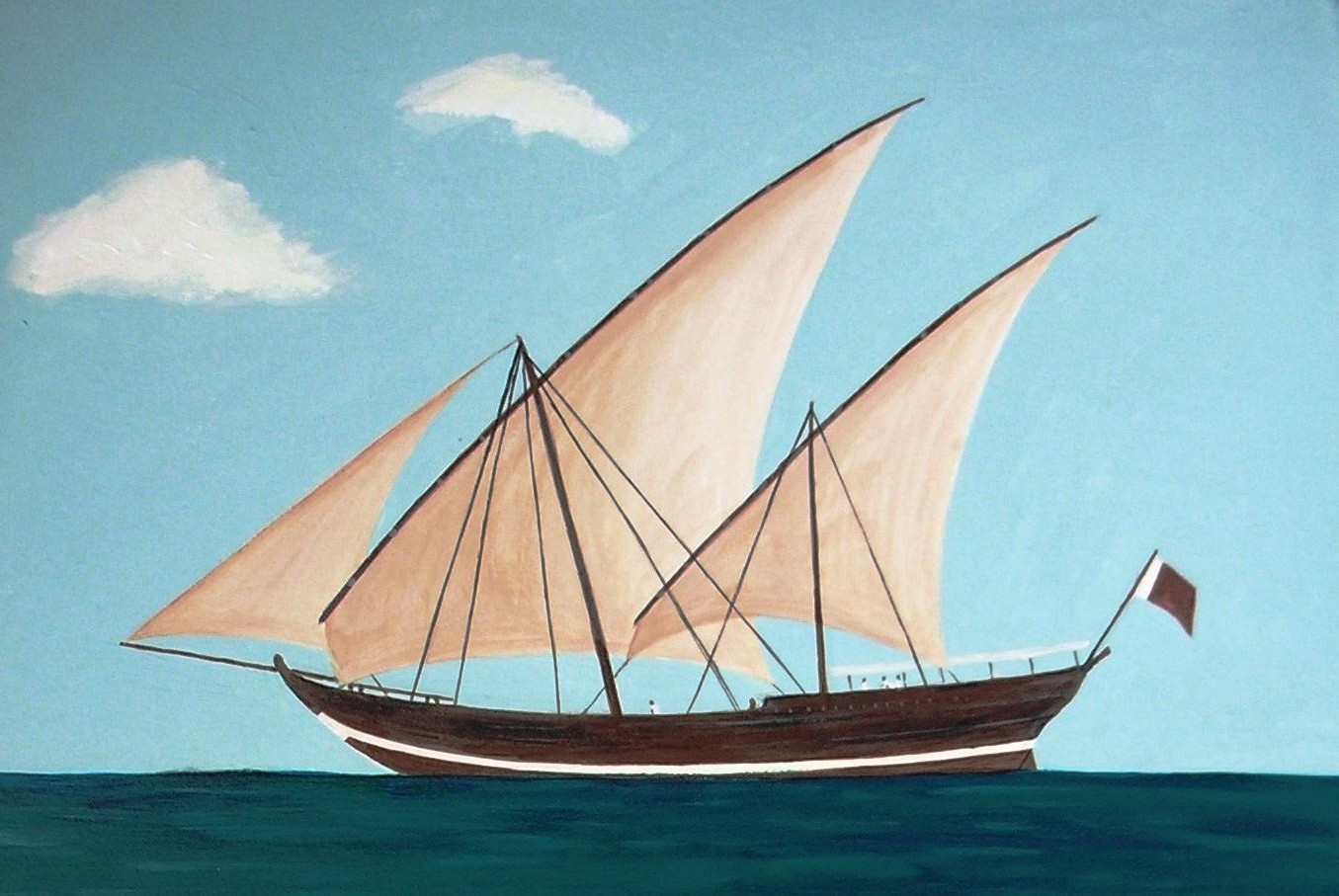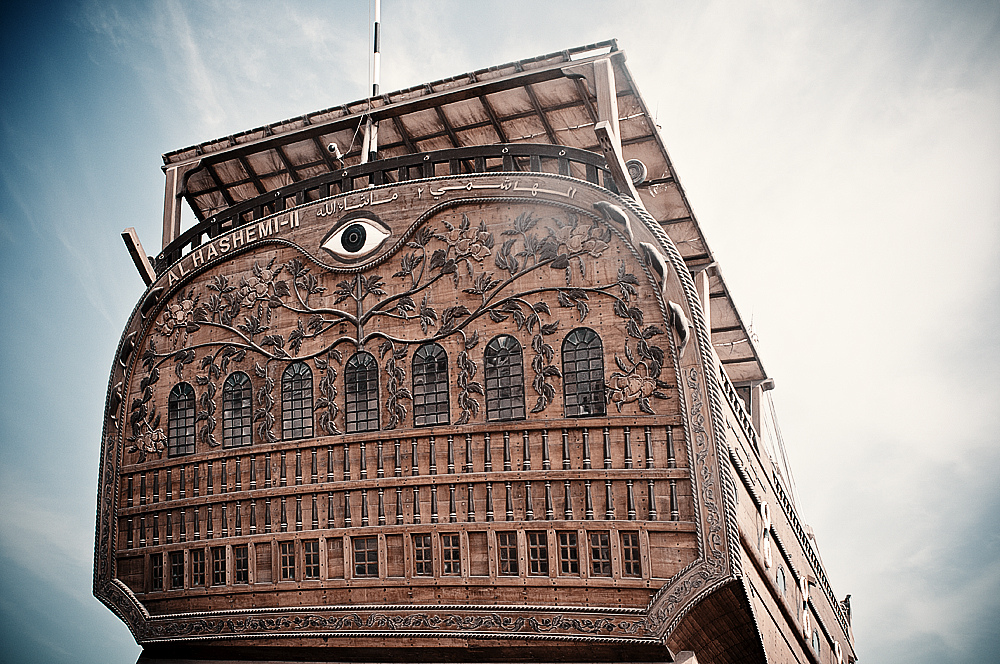baghlah on:
[Wikipedia]
[Google]
[Amazon]

 A baghlah, bagala, bugala or baggala ( ar, بغلة) is a large deep-sea
A baghlah, bagala, bugala or baggala ( ar, بغلة) is a large deep-sea
 The baghlah dhows had a curved prow with a stem-head, an ornately carved
The baghlah dhows had a curved prow with a stem-head, an ornately carved The Traditional Dhow
/ref>
Hikoichi Yajima, ''The Arab dhow trade in the Indian Ocean : preliminary report''
{{Sailing vessels and rigs Dhow types Sailing ships Arab inventions
 A baghlah, bagala, bugala or baggala ( ar, بغلة) is a large deep-sea
A baghlah, bagala, bugala or baggala ( ar, بغلة) is a large deep-sea dhow
Dhow ( ar, داو, translit=dāwa; mr, script=Latn, dāw) is the generic name of a number of traditional sailing vessels with one or more masts with settee or sometimes lateen sails, used in the Red Sea and Indian Ocean region. Typically spor ...
, a traditional Arabic sailing vessel. The name "baghla" means "mule
The mule is a domestic equine hybrid between a donkey and a horse. It is the offspring of a male donkey (a jack) and a female horse (a mare). The horse and the donkey are different species, with different numbers of chromosomes; of the two pos ...
" in the Arabic language
Arabic (, ' ; , ' or ) is a Semitic language spoken primarily across the Arab world.Semitic languages: an international handbook / edited by Stefan Weninger; in collaboration with Geoffrey Khan, Michael P. Streck, Janet C. E.Watson; Walter ...
.
Description
 The baghlah dhows had a curved prow with a stem-head, an ornately carved
The baghlah dhows had a curved prow with a stem-head, an ornately carved stern
The stern is the back or aft-most part of a ship or boat, technically defined as the area built up over the sternpost, extending upwards from the counter rail to the taffrail. The stern lies opposite the bow, the foremost part of a ship. Ori ...
and quarter galleries
A quarter gallery is an architectural feature of the stern of a sailing ship from around the 16th to the 19th century. Quarter galleries are a kind of balcony, typically placed on the sides of the sterncastle, the high, tower-like structure at th ...
. Their average length was with an average weight of 275 tons.
Usually they had two masts using two to three lateen sails
A lateen (from French ''latine'', meaning "Latin") or latin-rig is a triangular sail set on a long yard mounted at an angle on the mast, and running in a fore-and-aft direction. The settee can be considered to be an associated type of the same ...
; supplementary sails like a jib
A jib is a triangular sail that sets ahead of the foremast of a sailing vessel. Its tack is fixed to the bowsprit, to the bows, or to the deck between the bowsprit and the foremost mast. Jibs and spinnakers are the two main types of headsail ...
were often added on the bowsprit
The bowsprit of a sailing vessel is a spar extending forward from the vessel's prow. The bowsprit is typically held down by a bobstay that counteracts the forces from the forestays. The word ''bowsprit'' is thought to originate from the Middle L ...
, as well as on a topmast
The masts of traditional sailing ships were not single spars, but were constructed of separate sections or masts, each with its own rigging. The topmast is one of these.
The topmast is semi-permanently attached to the upper front of the lower ...
atop the main mast.
As a large and heavy ship the baghlah required a crew
A crew is a body or a class of people who work at a common activity, generally in a structured or hierarchical organization. A location in which a crew works is called a crewyard or a workyard. The word has nautical resonances: the tasks involve ...
of at least 30 sailors
A sailor, seaman, mariner, or seafarer is a person who works aboard a watercraft as part of its crew, and may work in any one of a number of different fields that are related to the operation and maintenance of a ship.
The profession of the s ...
. Some had even up to 40.
The ''ghanjah
A ghanjah or ganja ( ar, غنجه), also known as kotiya in India, is a large wooden trading dhow, a traditional Arabic sailing vessel.
Description
The ghanjah dhows had a curved prow with a characteristic trefoil ornament carved on top of the st ...
'' or ''kotiya'' is a similar type of vessel, often difficult to distinguish from the baghlah./ref>
History
Baghlahs were widely used in the past centuries as merchant ships in theIndian Ocean
The Indian Ocean is the third-largest of the world's five oceanic divisions, covering or ~19.8% of the water on Earth's surface. It is bounded by Asia to the north, Africa to the west and Australia to the east. To the south it is bounded by th ...
and the minor seas around the Arabian Peninsula
The Arabian Peninsula, (; ar, شِبْهُ الْجَزِيرَةِ الْعَرَبِيَّة, , "Arabian Peninsula" or , , "Island of the Arabs") or Arabia, is a peninsula of Western Asia, situated northeast of Africa on the Arabian Plate ...
. They reached eastwards to Sindh
Sindh (; ; ur, , ; historically romanized as Sind) is one of the four provinces of Pakistan. Located in the southeastern region of the country, Sindh is the third-largest province of Pakistan by land area and the second-largest province ...
, India
India, officially the Republic of India (Hindi: ), is a country in South Asia. It is the seventh-largest country by area, the second-most populous country, and the most populous democracy in the world. Bounded by the Indian Ocean on the so ...
and up to the Bay of Bengal
The Bay of Bengal is the northeastern part of the Indian Ocean, bounded on the west and northwest by India, on the north by Bangladesh, and on the east by Myanmar and the Andaman and Nicobar Islands of India. Its southern limit is a line between ...
and further beyond as far as the Spice Islands
A spice is a seed, fruit, root, bark, or other plant substance primarily used for flavoring or coloring food. Spices are distinguished from herbs, which are the leaves, flowers, or stems of plants used for flavoring or as a garnish. Spices ar ...
. Southwestwards they reached down to the East Africa
East Africa, Eastern Africa, or East of Africa, is the eastern subregion of the African continent. In the United Nations Statistics Division scheme of geographic regions, 10-11-(16*) territories make up Eastern Africa:
Due to the historical ...
n coast. They were one of the main types of ship used by the Bohra traders.
In the early 19th century these ships were also part of pirate
Piracy is an act of robbery or criminal violence by ship or boat-borne attackers upon another ship or a coastal area, typically with the goal of stealing cargo and other valuable goods. Those who conduct acts of piracy are called pirates, v ...
fleets operating from semi-independent or completely independent harbours in Persia
Iran, officially the Islamic Republic of Iran, and also called Persia, is a country located in Western Asia. It is bordered by Iraq and Turkey to the west, by Azerbaijan and Armenia to the northwest, by the Caspian Sea and Turkmeni ...
or along the Arabian Peninsula
The Arabian Peninsula, (; ar, شِبْهُ الْجَزِيرَةِ الْعَرَبِيَّة, , "Arabian Peninsula" or , , "Island of the Arabs") or Arabia, is a peninsula of Western Asia, situated northeast of Africa on the Arabian Plate ...
.Gardiner, Robert (2001 998
Year 998 ( CMXCVIII) was a common year starting on Saturday (link will display the full calendar) of the Julian calendar.
Events
By place
Europe
* Spring – Otto III retakes Rome and restores power in the papal city. Crescenti ...
. ''The Victory of Seapower''. Caxton Editions. . p. 89
During the 19th century, the Royal Navy
The Royal Navy (RN) is the United Kingdom's naval warfare force. Although warships were used by English and Scottish kings from the early medieval period, the first major maritime engagements were fought in the Hundred Years' War against F ...
attempted to suppress the Indian Ocean slave trade
The Indian Ocean slave trade, sometimes known as the East African slave trade or Arab slave trade, was multi-directional slave trade and has changed over time. Africans were sent as slaves to the Middle East, to Indian Ocean islands (including Ma ...
and in his 1873 book, Captain G. L. Sulivan described the "Bugala or genuine Dhow" as "by far the most numerous class" of dhow. (with engraving as illustration)
In favorable conditions a baghlah could sail up to 9 knots
A knot is a fastening in rope or interwoven lines.
Knot may also refer to:
Places
* Knot, Nancowry, a village in India
Archaeology
* Knot of Isis (tyet), symbol of welfare/life.
* Minoan snake goddess figurines#Sacral knot
Arts, entertainme ...
, but it was a somewhat unwieldy ship and was largely replaced by the easier to maneuver boom
Boom may refer to:
Objects
* Boom (containment), a temporary floating barrier used to contain an oil spill
* Boom (navigational barrier), an obstacle used to control or block marine navigation
* Boom (sailing), a sailboat part
* Boom (windsurfi ...
in the 20th century.
See also
*Persian Gulf campaign of 1809
The Persian Gulf Campaign, in 1809, was an operation by the British East India Company backed by the Royal Navy to force the Al Qasimi to cease their raids on British ships in the Persian Gulf, particularly on the Persian and Arab coasts o ...
* Boom (ship)
*Ghanjah
A ghanjah or ganja ( ar, غنجه), also known as kotiya in India, is a large wooden trading dhow, a traditional Arabic sailing vessel.
Description
The ghanjah dhows had a curved prow with a characteristic trefoil ornament carved on top of the st ...
*Shu'ai
A Shu’ai, Shu’i or Shuw'i ( ar, شوعي) is a small or medium-sized dhow, a traditional Arabic sailing vessel. This type of dhow is built low with a high quarter deck and has one or two masts with lateen sails.Agius, Dionisius (2008) A gen ...
References
External links
Hikoichi Yajima, ''The Arab dhow trade in the Indian Ocean : preliminary report''
{{Sailing vessels and rigs Dhow types Sailing ships Arab inventions